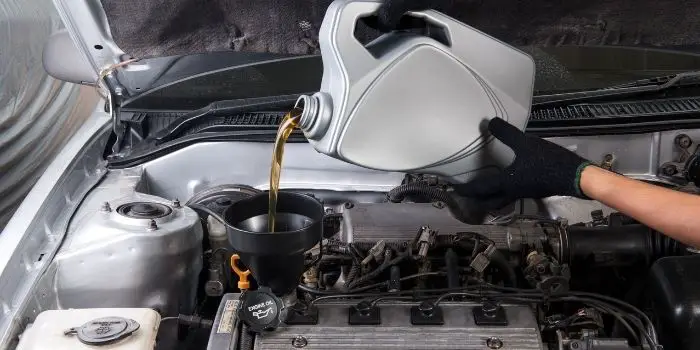Both 5w30 and 10w30 engine oils are multigrade oils. These oils are lubricants used in engines to minimize friction and prolong engine life.
But if you are perplexed by these engine oil codes, or don’t know which one is the best for what types of vehicles keep reading this article to the very end and all your doubts will be cleared.
After reading this short comparison guide, you’ll hopefully be able to understand the difference between 5w30 vs 10w30 engine oil, their meanings, benefits, uses, and which one is better.
Table of Contents
What is 5w30 Engine Oil?
It’s simply a lube for automotive engines. SAE 5w30 is another name for it because it is designated and numbered by the norms of the Society of Automotive Engineers.
The oil is named in such a way that it indicates the viscosity, appropriate weather, and thickness of the fuel.
As a result, the viscosity of the oil in this scenario is 5.
It has the letter ‘w’ signifying the weather since it covers the negative temperature scale.
It is most suited for usage in autos during the winter since it has a viscosity-temperature of at least -35 degrees Celsius.
Finally, the number 30 in the name refers to the thickness.
Benefits and Features
It offers several advantages and distinguishing characteristics.
It produces an ongoing layer across the engine elements and reduces friction between moving sections.
They prevent engine wear and tear and also aids in cooling the engine during heavily trafficked roads.
They also prevent the engine parts from rusting and extend the life of the engine.
They have exceptional thermal stability. In other words, it retains its characteristics even if there are large temperature fluctuations.
Now that we know about 5w30, let talk about the other one.
What is 10w30 Engine Oil?
It’s also an engine lube for different types of automobiles. They are known as 10w30 SAE lubricants since they also have been authorized and labeled by the SAE.
The viscosity of the oil is 10. As a result, it is substantially more viscous and denser than 5w30.
They are utilized in heavy-duty vehicles like trucks and heavy-duty autos.
Because the viscosity of the oil reduces with increasing temperature, the performance of the oil enhances at a larger temperature.
They are best utilized in the summer since they reduce viscosity and lubricate all sections of the engine properly.
This is why they are more popular in the summer than in the winter.
They are often used to lubricate outdated engines too.
Benefits and Features
It also boasts a plethora of advantages and distinguishing characteristics.
It also produces an ongoing layer across the engine elements, reducing friction between moving sections.
They also prevent engine wear and tear and also aids in cooling the engine during heavily trafficked roads.
They also prevent the engine parts from rusting and extend the life of the engine.
It also aids in smooth gears and clutch action as a result, noiseless engine running is feasible.
It also preserves viscosity even when the temperature varies widely but not as much as 5w30.
Finally, this lubricant may be utilized in engines that run on advanced fuels such as biodiesel or biofuel.
| 5W30 | 10W30 |
|---|---|
| Full Synthetic Motor Oil | Full synthetic formula |
| Meets Ilsac Gf-6 Standards | API ILSAC GF-5 grading passed |
| Has a Viscosity Index of 154 | Has a viscosity index of 146 |
| Its Best For Warmer Temperatures | Suitable for SUV and Most Truck Engines |
| Prevents the Deposits And Sludge Buildup | Sulfated ash% is 0.8 |
| Improves the Fuel Economy of Your Vehicle | Exception Cleaning Power with High Protection |
| Protects Engine Up To 10,000 Miles Between Oil Changes | Superior Friction Properties with High Oil Efficiency |
| Recommended By ExxonMobil For All Types Of Modern Vehicles | This all-season oil is also budget-friendly |
5w30 and 10w30: What are the Differences?
The main difference between both is 5w30 is oil for motor engines that are generally used for a greater range of temperatures, whereas 10w30 is suitable for engines at a lower range of temperatures.
The viscosity difference between these two lubricants is also noticeable. 10w30 has a higher viscosity than 5w30 and is also the heavier oil of the two.
Because 5w30 is less viscous, it can lubricate even the most difficult portions of the engine. But because 10w30 is thicker, this is not possible.
When the two are compared in terms of viscosity and temperature, there is an obvious contrast.
5w30 stays viscous over a wider temperature range. They can be used as lubricants at temperatures between negative 35 and positive 35 degrees Centigrade.
However, 10w30 has a narrower temperature range. They keep their viscosity only at temperatures between negative 16 and positive 30 degrees Centigrade.
Because 5w30 engine oils cover a wider temperature range, including temperatures as low as -35 degrees Celsius, they are appropriate for cars operated throughout the winter season or in colder climates.
Though 10w30 has a narrower temperature range, it is utilized as a lubricant for automobiles in the summer since its viscosity is inversely proportional to temperature.
The two engine oils are intended for usage in various sorts of automobiles. This is due to the disparity in viscosity and the range of temperature.
5w30 lubricant is used in lighter automobiles, while on the other hand, 10w30 is utilized for heavy-duty autos such as buses and trucks in general.
Can You Put 10w30, 0w30 or 5w40 in a 5w20 Engine?
0w30, 10w30, 5w40, 5w30, 5w20, etc are all different grades of motor oils.
The basic differences are in terms of thickness (or viscosity) and at the temperatures, they can operate safely.
5w40 for example has a higher viscosity than 5w30 hence it is not suitable at all temperatures.
If you need to use 5w30 instead of 5w40 (5w20, 0w30, 10w30) or vice versa, keep in mind their viscosity and the operating temperatures.
Also, check the manufacturer guidelines and recommendations for the oil grade for a specific type of engine in which these oils can be used.
An engine manufacturer can deny any kind of warranty claims just because you used the wrong grade oil.
Moreover, if you happen to put the wrong engine oil it will take a longer time to pump up pressure for your bearings and lifters.
Plus, the oil will not be able to spray your lower cylinders for an extra second or so on each cold start.
As a result, you will be getting worse mileage which can eventually also cause the shortening of the life of your engine.
Final Thoughts – Which Motor Oil is Better?
To summarize, 5w30 is superior since it is more suited for usage in locations with a lower temperature, such as negative 35 degrees Centigrade as well as areas with somewhat warm climates, where temperatures go beyond 35 degrees Centigrade.
On the other hand, 10w30 is used in the summer and is not favored in the winter because it requires high temperatures in the engine to decrease its viscosity and better lubricate the engine, so summer is the only optimum season for it.
They are both good in their own right, but 5w10 wins since its viscosity is just 5, which means it is thinner and can reach the problematic sections of the engine better for its lubrication.
So this was all about these two engine oils, we hope you found this short guide helpful and are now finally on the level to distinguish between them.

Based in Orem (Utah) John Paterson graduated from Utah Valley University and has begun writing in 2009. He has a large wealth of experience in writing articles related to cars, automotive repair, wheels, cleaning/maintenance, and much more. He has also written instructional articles in a similar niche for a few online publications as well. Currently, he works as a mechanic in his personal garage shop where he loves serving his countrymen from his heart.







